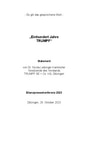TRUMPF feiert mit dem aktuellen Geschäftsbericht ein bedeutendes Jubiläum – und 100 Jahre Innovationsgeschichte. Auf den ersten 100 Seiten zeichnet dieses Meilenstein-Dokument die Reise unseres Familienunternehmens nach und beleuchtet die wirtschaftlichen, politischen und technologischen Entwicklungen, die unsere Geschichte maßgeblich prägten. Durch beeindruckende und bisher unveröffentlichte Bilder aus unserem Archiv sowie durch anschauliche Illustrationen zu verschiedenen Technik-Highlights wird deutlich, wie wir zu dem Innovationsträger wurden, der wir heute sind: Ein weltweites Unternehmen, das mit Ultrakurzpulslasern, Quantentechnologie und EUV-Lithografie die Zukunft unserer Welt mitgestaltet. Erleben Sie einen Geschäftsbericht, der nicht nur in die Vergangenheit blickt, sondern auch einen inspirierenden Ausblick auf die nächsten 100 Jahre bietet.

TRUMPF Geschäftsjahr 2022/23
Trotz noch spürbarer Corona-Folgen, Lieferkettenproblemen und dem russischen Angriffskrieg in der Ukraine hat TRUMPF das Geschäftsjahr zum 100. Firmenjubiläum mit großem Erfolg abgeschlossen. Ein Auftragseingang von 5,1 Milliarden Euro und ein steigender Umsatz von 5,4 Milliarden Euro zeigen die Stärke und Anpassungsfähigkeit unseres Unternehmens. Ein operatives Ergebnis vor Zinsen und Steuern von 615 Millionen Euro sowie eine Rendite von 11,5 Prozent runden das Geschäftsjahr 2022/23 ab.
Danke!
100 – Der Geschäftsbericht im Jubiläumsjahr


Titel: 100
Wir beginnen mit einem Namen, einer kleinen Werkstatt und einer Idee
Wir beginnen im Jahr 1923 als Christian Trumpf die Werkstätte der Julius Geiger GmbH erwirbt. Was dann passiert? Sehen Sie selbst und staunen Sie über beeindruckende Bilder und Aufnahmen aus unserem Unternehmensarchiv. Film ab!
Geschäftszahlen
Downloads

Titel: 100

Von Dr. Nicola Leibinger-Kammüller, CEO TRUMPF Gruppe


zip
Ihr Pressekontakt




